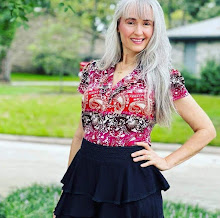

***Many of my readers are saying how much they love McCall's 4425. Well, I love it, too. I want it. The only place I could find it for sale is The Vintage Peddler for $185. I'm not about to pay that much for a pattern. So I called McCall's and requested that they reprint this pattern. Maybe if several of us call them with the same request, they will. Just be sure and tell them it's the McCall's 4425 from the 1950s or they may reprint the wrong one since they reuse these numbers.***
(First photo is Vogue 7383)
This is an incredible article from Time Magazine, 1958, that I think you will thoroughly enjoy.
"MODERN LIVING: SEW AND REAP
TIME MAGAZINE, MONDAY, NOVEMBER 10, 1958
SOURCE: http://www.time.com/time/magazine/article/0,9171,938058-1,00.html
Some soldiers send epistles, say they'd sooner sleep in thistles than the saucy, soft, short shirts for soldiers sister Susie sews.
—World War I ditty
Since World War I, the fingers of Susie —and her sisters—have become as nimble as professionals—and thereby started a new kind of home sewing boom. In the 1920s women who could not afford to buy even cheap store dresses did most of the home sewing. But no longer. Women are still sewing to economize—but on the fanciest dresses that Paris can design. Inundated by fashion news, furiously taking up and letting down to keep in style, some 35 million women are sewing profits for an industry that will reap close to $1 billion this year. Home sewers will spend $400 million for fabrics, $290 million for accessories, $270 million for home sewing machines, $40 million for 90 million patterns. About 20% of all feminine clothes are now made at home by women who sew an average of four to six garments a year.
Trading Up. Every calculated change in Paris means more money spent. So fashion-bent have sewing women become that patternmakers have all but junked the simple housedress designs that used to be their bread and butter. What more and more women want is the kind of high-fashion Vogue patterns long sold by Conde Nast. The originals would cost perhaps $600, but-almost any woman can copy them for the cost of a $3 pattern and $50 worth of fine fabric (Vogue patterns even supply a Paris label).
McCall Corp. (1958 pattern sales: $11 million) is matching other patternmakers in their new efforts to stay only a few months behind Paris. Last spring McCall produced the Dior trapeze line at the same time it appeared on U.S. ready-to-wear racks. Last month it brought Paris Couturier Pierre Cardin to the U.S. for a nationwide tour to publicize the six designs that he has made specifically for McCall's fall catalogue. McCall, says Pattern Boss Herbert Bijur, "is frankly trading up into the Vogue class."
Well below the high-fashion class is Simplicity Pattern Co., No. 1 in the field and the only maker that sells nothing else (expected 1958 sales: $20 million). "We work for the girl next door," says President James J. Shapiro. "We want to sell Fords with lots of chrome, not Cadillacs."
Art Form. The biggest pattern buyers are now women in families with incomes above $7,500. Millions of women now rank sewing as their No. 1—and often only—hobby. "There's a whole new climate," says Simplicity's Shapiro. "They do it as an art form."
All elements of the sewing industry have combined to launch a huge sew-more campaign. Manhattan's R. H. Macy, boasting probably the biggest piece-goods department in the world, runs home-sewn fashion shows every day for about 14 weeks a year. Singer Manufacturing Co. spends $3,000,000 a year on national advertising, gives free machine lessons at 1,700 Singer Centers to 363,000 women a year, sponsors annual sewing contests with contestants winning $210,000 in prizes. One return prize for the industry is more and more younger sewers: the average home sewer's age has dropped from 45 in 1928 to 27 now, and by 1960 millions of teen-agers will be sewing. A common but fashionable wedding present for suburban brides: a sewing machine.
No Dry Cleaning. What makes sewing more interesting than ever is that it is vastly easier. Even the clumsiest bachelor girl can sew professional-looking draperies with the aid of pre-pleating devices. Such accessories abound. John Dritz & Sons carries 100 items, introduced 18 new ones this year alone, including a "foolproof" buttonhole maker, electric scissors, upholstery-repair kit.
Sales of home sewing machines have more than doubled since 1948, to about 1,500,000 a year, because the new machines embroider, darn, quilt, overcast, link two edges without overlapping, sew on buttons, make buttonholes—do virtually everything except dry cleaning. These wonders are mainly attributable to the invasion of foreign machines (about 1,000,000 a year), such as Italy's Necchi, which ten years ago caught staid old Singer with its slip showing. The new gadgets on Necchi and other machines shrank Singer's sales in the U.S. from its two-thirds grip of the U.S. market to one-third. Now Singer is bouncing back. It says that its Slant-O-Matic, $399.50 in Early American cabinet, can match-sew any foreign make. Soon sister Susie should sew a shirt in seconds."
















































.JPG)




Wow! $400 for a sewing cabinet in 1958?
ReplyDeleteI just bought 3 very old sewing machines last night at an auction. I'm anxious to try them out this weekend.
And TONS of antique fabric! I'm getting items for my booth at the antique mall ready in my free time.
Have a great day!
Too bad Singer and Necchi didn't stay in their respective countries and/or maintain their quality.
ReplyDeleteIn 1958, can you imagine being able to spend $3 for a pattern and $50 on fabric for one dress?! (I wouldn't spend that now unless I was making a wedding dress. I always wait to buy patterns when they are on sale.) I think Simplicity and McCall patterns must have been 10 to 25 cents, because they were 35 cents when I was in elementary school.
PS: I cannot find the info on that doll book. I'll keep watching for it, though.
This was such an interesting article! One of the things I love about sewing is the feeling that I am participating in an art form that has such a fascinating history. I am afraid I can't offer any advice on your trouble with uploading image files. I periodically have similar trouble, but I have never been able to determine whether it was a problem with Blogger, or a problem with my computer or Internet connection.
ReplyDeleteExcellent article! There are a lot of neat little tidbits in there.
ReplyDeleteWhat a great article! I covet the McCalls 4425 pattern . . . fabulous look! I'm afraid I'm showing my age, because I remember those days long ago when major department stores had sewing sections and sold patterns and fabric. Today, not only do those stores NOT sell fabric, most of them have gone out of business!
ReplyDeleteLOVE McCalls 4425......
ReplyDeleteGreat article - thanks so much for reprinting it, I love reading about sewing history!
ReplyDeleteLove learning about the history of my favorite craft. And I wish I owned those two patterns.
ReplyDeleteThanks,
C
Both of those patterns are incredible. Fingers crossed for reprints!
ReplyDeleteThe McCalls 4425 vintage pattern is being offered as a copy at www.Craftzies.etsy.com :)
ReplyDelete